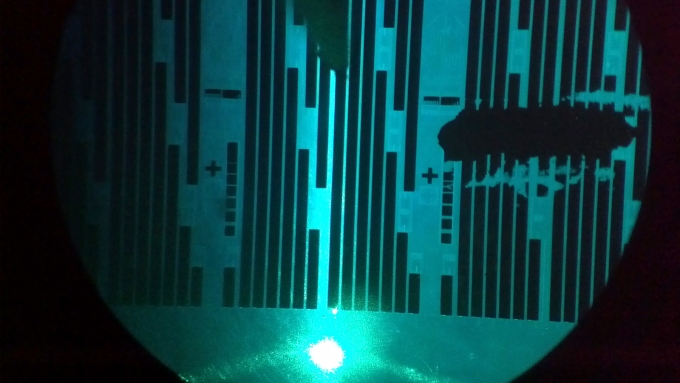In the early 1990s Steven DenBaars began an effort that culminated in 1997, when UCSB became the first university to secure a gallium nitride (GaN)–based laser diode. It was only the fifth such device in the world. The vision was to use it to improve Blu-ray laser technology and then to develop portable laser TV projectors, which, he said in 2017, “We’re still working on twenty years later.”
The first CD technology used an infrared laser to read the disc. That changed when Shuji Nakamura and his partners invented the violet laser, which had a shorter wavelength and correspondingly higher frequency and could therefore read much more information much faster.
That violet laser empowered the slightly misnamed BluRay technology. Later, at UCSB, Nakamura, DenBaars, and James Speck found that by doping GaN — in this case, adding about 10-percent indium to change the crystal chemistry and add more electrons at the crystal interface — they could change the color of the laser from violet to blue and green.
Early GaN lasers had an inherent problem in that their optical capacity was limited by electric fields related to internal polarization on the GaN crystal. In 2001 Speck initiated the process of developing non-polar and semi-polar GaN lasers and then worked closely with Nakamura on the problem over the next several years. A main thrust of their efforts was to investigate GaN-based laser diodes grown on nonpolar planes of the crystal, the so-called “B” and “C” planes, which are free from performance-diminishing, polarization-related electric fields.
But it wasn’t an instant success. “When we first began studying nonpolar and semi-polar GaN crystals, the results were very poor; light emission was close to zero,” Nakamura recalled in 2017. But a breakthrough occurred in 2006, when the team produced the first non-polar and semi-polar GaN LEDs, fueling an ongoing string of breakthroughs in laser optics and generating multiple related patents.
The researchers also created high-efficiency LEDs and blue lasers by developing GaN-on-GaN
semiconductors, which had far fewer defects than GaN crystals grown on other substrates, such as sapphire. Reducing the defects increased the efficiency of the resulting laser diodes while also extending their life. The first semi-polar and non-polar blue-violet laser diodes, developed at SSLEEC in 2006, had ten times the density of Blu-ray players that were then commercially available. It was made possible by the increasingly high-quality GaN-on-GaN crystals.
A good amount of current SSLEEC research focuses on developing laser lighting in the expectation that it will eventually replace LED lighting. While SSLEEC was the first academic center in the world to work on laser lighting and was still the only one in 2017, industry has been quick to adapt, and the first commercial products have appeared in the past few years. One of them, the laser headlight on BMW cars, increases night visibility by seven hundred meters, to a full kilometer. The blue laser is converted to white light by using a phosphor crystal, which also removes the “coherence” — the quality that makes laser light a pinpoint beam — so that its emits light in 360 degrees, which can then be directed at the appropriate angle in front of the car.
Laser projectors, another new development enabled by laser-diode technology developed at UCSB, are now being used in hundreds of theaters in China and Japan, and laser-based projector televisions are undergoing trials. Projector TVs first appeared in the 1990s, but they failed because they were too big and not bright enough. Lasers, however, are incredibly bright and so, unlike current LED TVs, which can be no thinner than the LED bulbs behind the screen, a laser television, which is just a screen that has an image projected onto it, it can be wafer thin. Laser TVs will also be brighter than the best LED TVs and have better colors and resolution.
In the not-distant future, large outdoor displays like those in stadiums and city centers will likely be based on laser light rather than the current LED technology, which was introduced in the late 1990s. Another possible area of application is Li-Fi,
where laser-based Li-Fi would offer a major leap in processing speeds over those of LED–based technology, which are already much faster than Wi-Fi, which uses radio waves.
The challenge with laser technologies is to make them smaller. That requires the lasers — currently about half as efficient as LEDs — to be more efficient and more powerful so that they can accommodate long battery life. To achieve that, DenBaars says, “You make things like the non-polar crystal, you change the way you cut the crystal. You’re looking for the right layer, the right crystal orientation, the right materials, the right doping atoms. It’s just the magic of materials science.”
It is no stretch to say that laser technology is ever improving thanks to the brain trust at SSLEEC.

A series of edge-emitting laser structures
